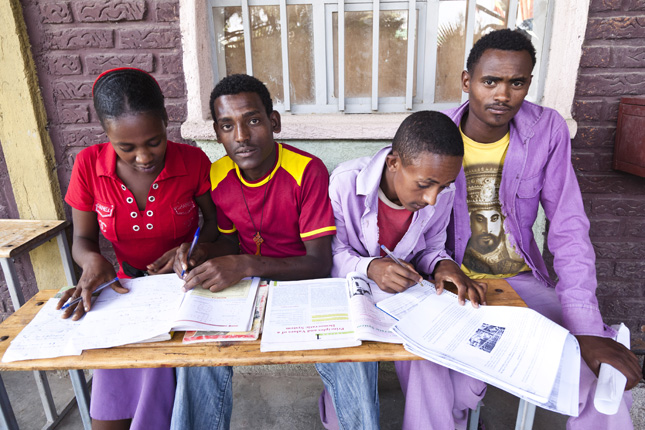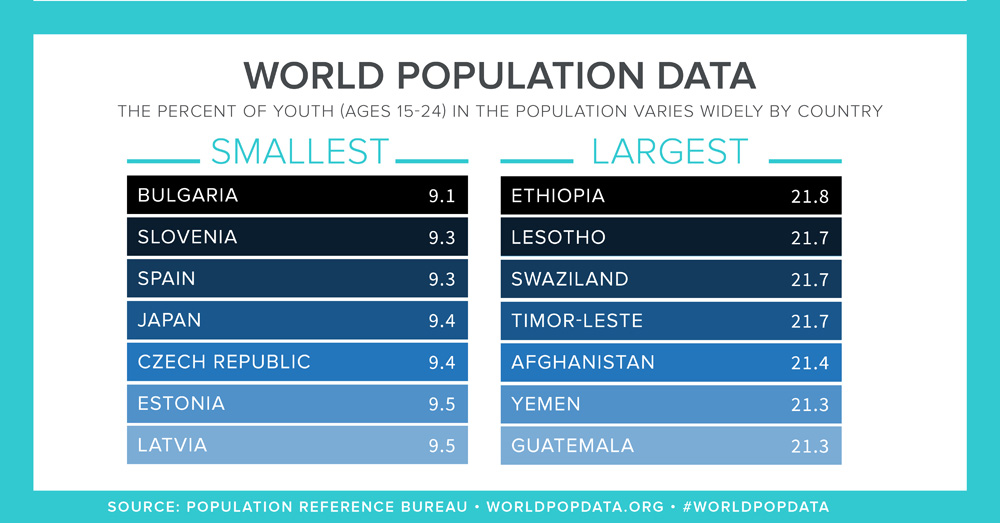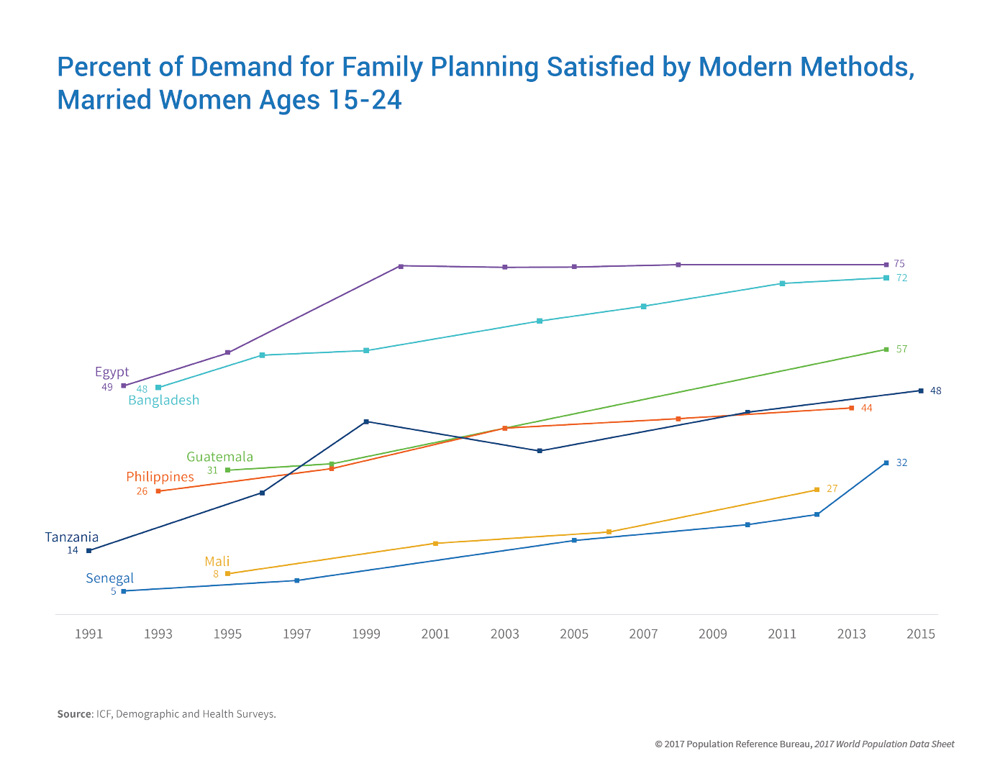-
Ensuring Today’s Youth Become Tomorrow’s Successful Adults
September 26, 2017 By Peter Goldstein
The future of global security will depend in large part on the fate of today’s 1.2 billion young people. Do youth between the ages of 15 and 24—a critical phase of life—possess the necessary social, physical, intellectual, and financial building blocks to underpin productive, healthy adulthoods? Or do they lack this solid base, putting them at risk of personal and social instability?
The World Population Datasheet from Population Reference Bureau (PRB) paints a mixed picture, at least from a purely statistical point of view. The widely referenced Data Sheet, produced annually since 1962, compiles key population and health indicators as well as population projections for world regions and more than 200 countries. This year’s edition includes special indicators that measure the well-being of youth. Graphic analyses show notable progress in some key areas, but also reveal yawning regional and gender disparities. And while young women have made progress in many important areas, such as access to modern family planning methods, they still lag young men in many others, including access to education, employment, and training opportunities.
First, here are a few basic yardsticks on the global youth population from the Data Sheet:
- The world youth population (ages 15 to 24) is projected to reach to 1.4 billion in 2050 from 1.2 billion now. However, the youth share of world population will fall to 14 percent from 16 percent, reflecting strong growth in older populations in many parts of the world.
- Africa will be home to 35 percent of the world’s total number of youth by 2050, rising from 20 percent today. Africa will also account for about 60 percent of the increase in the total world population by 2050, to 9.8 billion from 7.5 billion currently. Africa’s total population is projected to more than double to 2.6 billion by midcentury.
- Ethiopia currently has the highest proportion of youth in its population at 21.8 percent, while Bulgaria has the lowest at 9.1 percent. Regionally, the youth share of the population is 19 percent in Africa, 16 percent in Asia, 16 percent in the Americas, and only 10 percent in Europe (including Russia).
- The global adolescent fertility rate is 50 births per 1,000 young women (ages 15 to 19), compared to only 16 per 1,000 in more-developed countries and 54 per 1,000 in less-developed countries. In the 49 least-developed countries in the world, the rate is 106 births per 1,000 women.
These data underline the importance of viewing the global youth population from a regional perspective. Clearly, certain areas face significant youth bulges that call for creative policy choices to ensure that young people have sufficient opportunities for education and employment. On the other hand, particularly in many developed countries, the number of young people will not be sufficient to financially and socially support rapidly aging populations, leading to tough choices for governments on the fiscal and social benefits fronts.
Young Women, Minorities Less Likely to be in Education, Employment, or Training
The NEET indicator (Not in Education, Employment, or Training) measures the percentage of youth—typically ages 15 to 24—who are not in school, not working, and not in training for work. Without this experience, they are missing opportunities to develop their full potential in adulthood.
Except for most high-income countries, young women have generally higher NEET rates than young men. Young women often have less access to jobs, education, and training, and are more likely to be fully engaged in non-labor market activities, such as caregiving and household work. Middle-income countries (especially the lower middle-income countries) have the highest NEET rates and the largest gender disparities. Many low-income countries do not have data on NEET, but when they do, the rates are generally low, since many youth are actually engaged in informal livelihood activities, such as subsistence farming. Given rapidly growing youth populations in low-income countries, particularly in sub-Saharan Africa, NEET rates are likely to rise unless investments are made in more educational and job opportunities for youth.
In the United States, youth have made progress in productive activities since the Great Recession in 2007, but there are still disparities. Before the Great Recession, only one in 10 non-Hispanic white youth (ages 16 to 24) were not enrolled in school or working, while the share among minority youth was higher, ranging from one in six to one in four. By 2010, the share of youth not in school or working had risen among every racial/ethnic group, except Hispanic females, where it decreased slightly.
By 2015, however, the share of U.S. youth who were not attending school or working had returned to or dropped below prerecession levels for all gender and racial/ethnic groups, except non-Hispanic white males. Even so, there are still sizeable gaps between white and minority youth: more than one-fifth of black males were still not in school or working in 2015.
Young Women Face Unique Barriers to Family Planning
Sustainable Development Goal (SDG) 5 on gender equality calls on the international community to empower women to make informed decisions about their reproductive health. Over the last two decades, increasing numbers of married women ages 15 to 24 in many low- and middle-income countries have met their needs to delay or limit childbearing with modern methods of contraception. But challenges and barriers unique to younger women slow progress in several countries. Age-restrictive policies, social pressures, and biases of healthcare providers limit young women’s knowledge of available options and access to appropriate methods, leading to higher rates of contraceptive failure and discontinuation after short periods. Addressing these barriers will improve maternal and child health, increase educational attainment, and improve economic opportunities for young women.
Risky Behaviors Increase, Driving Noncommunicable Diseases
Unhealthy habits such as tobacco use, alcohol abuse, lack of exercise, and poor diets typically take root in adolescence or young adulthood. These behaviors are key risk factors for developing serious noncommunicable diseases (NCDs)—notably, cardiovascular diseases, chronic lung diseases, diabetes, and cancers—which are a growing problem in every region of the world. The four risky behaviors are increasing or already at high levels among youth, including those in many low- and middle-income countries. In some settings, school-based education and behavioral change programs are lowering tobacco and alcohol use, and policy interventions, such as taxation and advertising bans for tobacco products, have also had positive effects. Addressing young people’s risky behaviors is essential to curbing a growing NCD epidemic in low- and middle-income countries and to helping youth become healthy adults.
Access to Computers, Internet Varies Widely
Developing skills in information and communication technologies (ICTs) is critically important for youth seeking to compete in the increasingly digital global economy. ICTs can play a catalytic role in education, as reflected in the inclusion of SDG measures focused on computer and internet availability in schools. Outside of schools, youth in more-developed countries benefit from widespread access to computers and the internet, while youth in less-developed countries in sub-Saharan Africa and Southeast Asia have the lowest rates of access. Increasing use of smartphones in these regions will boost internet access rates: In sub-Saharan Africa, smartphone use as a share of total mobile phone use will jump from 28 percent in 2016 to 55 percent by 2020.
As our world population continues to expand and our resources strain to keep up, this generation of young people—the largest in history–will face numerous challenges. Now is the time to ensure that as many young people as possible are well-equipped so we can create a stable, healthy world community for all of us, no matter our age.
Peter Goldstein is vice president of communications and marketing at the Population Reference Bureau.
Sources: Population Reference Bureau, UNESCO
Photo Credit: Ethiopian youth studying, November 2011, courtesy of UNICEF Ethiopia.
Topics: demography, development, economics, education, family planning, featured, gender, global health, Guest Contributor, youth
 A Publication of the Stimson Center.
A Publication of the Stimson Center.








